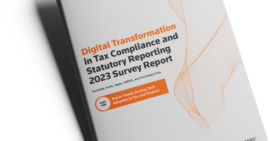“In today’s world, zero non-compliance is the norm,” warns Vishal Parekh, Regional Head, South Asia and South-East Asia at Thomson Reuters. “No one wants to be in that bucket of being non-compliant to local regulations – because that becomes a boardroom topic.”
“The mantra has always been for all of us in the finance function and the in-house centres to do more with less and to move up the value chain,” adds Vishal, in his opening remarks at the recent Return to Better: Solving the Global Financial Reporting Challenge Virtual Roundtables on 30 September.
In response, for the last few years there has been a surge in centralising and automating complex functions like Statutory Reporting – and tax compliance.
Growth in Centralised Statutory Financial Reporting
Recent figures from a survey conducted by the Shared Services & Outsourcing Network (SSON) and Thomson Reuters show that early three-quarters of respondents have either already centralised statutory reporting or plan to centralise it within the next three years.
The current pandemic has also dramatically increased the interest in centralisation and standardisation, explains Vishal. Although cost efficiency has always been the key driver for this move to centralising operations, more recently this decision has also been taken from a risk mitigation standpoint, to ensure those processes are compliant with the rapidly changing local regulations.
Transformation: Getting Started
The verdict is in, so how do we make the change?
Uddhav Pandit, Vice President, Finance Global Shared Services at Capgemini, Chaired the Roundtable to share his experience on how to leverage technology specifically to solve for Statutory Financial Reporting, and the challenges along the way.
When Capgemini, a consulting technology and outsourcing service provider with a 14-billion-euro turnover, started its finance offshoring journey to India in 2007, it was not in fact with the purpose of offshoring Statutory Financial Reporting.
“Addressing Statutory Financial Reporting was just a logical evolution of everything else we did,” he explains. And as Hari Ganesh Kumar, Enterprise Proposition Lead at Thomson Reuters adds, “centralising processes like Statutory Financial Reporting is part of the natural progression of moving up the value chain and doing more value-add work”.
First Capgemini moved its transactional services, including supplier invoice accounting and employee reimbursements to its Shared Service Centre (SSC) and, over time, the scope of work managed centrally in India now ranges (for its smaller entities) from controllership activities and General Ledger (GL) maintenance to Statutory Financial Reporting. “And, as we speak, this list is growing,” says Uddhav.
Challenges and Benefits
Despite this huge growth which has allowed Capgemini to leverage the benefits of scale and use common teams for multiple entities and benefit from certain automation initiatives, there is also some resistance to making this transition.
Some of the hurdles of managing Financial Reporting across multiple jurisdictions, include maintaining local staff, meeting local compliance requirements, dealing with local language constraints which vary from country to country – and making the move from manual reporting in Word and Excel.
Although the original plan for Capgemini was only to centrally offshore transactional services, and handle GL maintenance locally, after a while this was not efficient – and it became a challenge to hire, train and keep local talent, and attrition took hold. This forced them to move their GL activity to their central SSC in India, where they now have their financial statements audited. Adding Statutory Financial Reporting was a logical evolution thereafter.
Automation, overlayed with local resources, is the big answer to how to keep up with local regulatory changes across all jurisdictions, say Hari. “In an automated process 80-90% of your GL data is mapped through particular account line items which then produce your financial statements.”
Moving Away from Word and Excel
One of the big impacts of standardising and centralising involves the move from Word and Excel to a more automated way of working. And version control is the clear benefit! Many countries have their own accounting standards, requiring a strict tracking regime for which using Excel became too risky for Capgemini.
“The benefit is also to ensure there is now a proper audit trail from the ERP system to the accounting reports and to manage whatever accounting gap there is in existing entries and maintain an audit trail for that.”
Handling Transformation
Implementing transformation projects comes with huge demands on many sectors of the business. Which is why they all need to be included, according to Uddhav.
“Transformation is all up to how you manage the change. Having a buy-in/user group – which involves all aspects of the company is a must. Do not underestimate the change management initiative!” warns Uddhav.
Automation: The Bigger Picture
Reflecting on the benefits of technology, Hari shares his views on the bigger picture.
“If you can free up people’s time from doing manual tasks that can be automated using a central technology platform, it gives them more time to reflect on and analyse their numbers. And with financial reporting specifically you’re not checking: do my numbers add up? but – what is this telling me about the business? What is the story I want to portray to my investors or to my stakeholders?
“It has to be more than a pure cost-play – it’s got to be: what are we really trying to achieve? And this higher purpose to make sure we are compliant in each country and we’re never going to miss a filing deadline.”
And a final word from Uddhav who explains that the bigger focus is shifting from year cost to efficiencies.
“I think the purpose of the whole shared services centre that we have set up has moved away from just cost optimisation to bringing in efficiencies.
“It’s not so much about how many FTEs are saved, but how much speed we bring to the process, how much sooner can we complete the reporting and so on.”
And thanks to the automated processes they have adopted, “location will no longer be a constraint,” concludes Uddhav.


